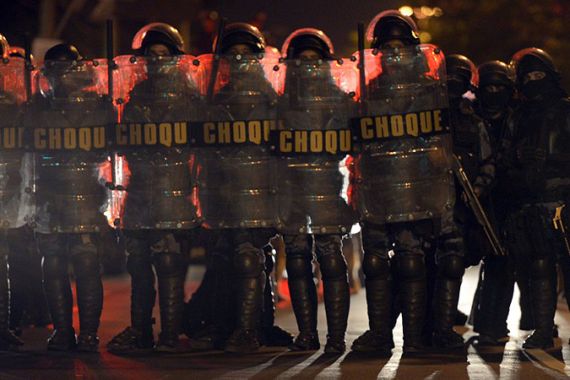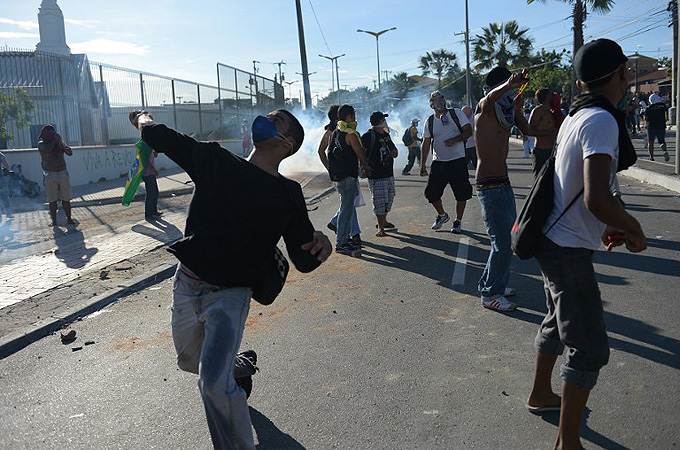Police violence under review in Brazil
Criticism of police using excessive force intensifies as mass demonstrations continue.

Rio de Janeiro, Brazil – “The repressive police on the streets is the same one that kills in the favela,” read a large sign carried at a protest last week, when thousands took to the streets in Rio de Janeiro’s city centre.
The words symbolise what has become a major reason why people are protesting in Brazil: to seek an end to pervasive police violence throughout the country, critics say.
Mass street protests in Brazil that started over public transport fare increases – and which spread like wildfire nationwide the past few weeks – have led to violent police outbursts and the arrest of hundreds of people, raising concerns among human rights groups and outraging demonstrators.
More protests are expected Sunday in Rio near the stadium where Brazil and Spain are set to play the final match of the FIFA Confederations Cup. About 10,000 police officers are expected at the venue – the largest security operation ever at a football match in Rio.
“At the end of some of the protests, there has been very violent behavior by some groups,” said police Colonel Frederico Caldas. “We had vandalising in the city centre that damaged buildings, banks, and monuments. The role of the police now is to promote order at all costs and prevent that from happening again.”
But as the demonstrations continue, accusations of police brutality have grown louder.
 |
| Brazilian police fire on demonstrators last week [Reuters] |
Reporters Without Borders correspondent in Brazil, Luiz Gustavo Pacete, told Al Jazeera that nearly 30 journalists have been hurt during clashes between police and protesters, while four have been arrested. Charges vary from conspiracy to commit crimes to carrying vinegar bottles, which can ease the affects of tear gas.
It is unclear how many of the estimated one million or so protesters taking to the streets this month have been hurt in Brazil’s demonstrations.
Rubber-coated bullets
Sérgio Silva, a freelance photographer for Futura Press, was hit in the face by a rubber bullet while covering a São Paulo demonstration, and doctors say there’s a 90 percent chance of losing sight in his left eye.
Silva told Al Jazeera he was hiding behind a newsstand with other journalists when police fired to scatter a multitude of protesters.
“People were running towards me and I could take one single shot of where the rubber bullets were coming from when I was hit,” Silva said. “That bullet was not shot towards the ground, as it should be. I’m 178 centimetres tall and was hit in the eye as proof of it.
“I’m a freelancer and the state has taken away my means to provide for my family,” he said.
Another reporter, Giuliana Vallone, working for the Folha de S. Paulo newspaper said she was also shot in the face by police with a rubber bullet.
“They had aimed at me before that evening, but no one had shot,” Vallone said from a hospital bed with a severely swollen black eye. “I was working, I am a woman. I could never imagine a uniformed policeman would shoot me in the face.”
Another incident that angered protesters was a photo posted online of a police officer blasting pepper spray into the face of a woman.
São Paulo state police said all cases alleging police brutality formally filed, including the journalists’, would be investigated. Secretary of Public Safety Fernando Grella Vieira said he is sorry for what happened and has opened an investigation.
‘Pacifying’ the slums
Although the rubber-coated bullet shootings have raised concerns, live ammunition is frequently used in police operations in the slums of Brazil’s largest cities, the so-called favelas.
”BOPE
sees the favelas as war zones. Police strategies inside the favelas do not respect rules.”]
Far from Rio’s centre, 10 people were killed on June 24, including one police officer, in a police raid in Maré district. An estimated 130,000 people live in the area on the outskirts of the city.
Jailson de Souza e Silva – university professor and founder of Observatorio de Favelas, a social organisation based in Maré – told Al Jazeera that irresponsible incursions by police are nothing new to local residents.
“BOPE [Special Operations Police Brigade] sees the favelas as war zones,” he said. “Police strategies inside the favelas do not respect rules. They often shoot power converters so we don’t have light, and break into people’s houses without legal orders.”
The Public Safety office said Special Operations Command chief, Colonel Hugo Freire, held a meeting last Wednesday with community leaders, and police opened an investigation into the deadly raid.
Jose Miguel Vivanco from Human Rights Watch (HRW) told Al Jazeera that police officers face serious dangers when confronting Brazil’s violent crime.
“However, legitimate efforts to improve public security have all too often been undermined by officers who commit unlawful acts and grave abuses, such as executing people and falsely claiming that they died in shootouts,” Vivanco said.
He said HRW has documented many “resistance” killings by police, and said it was “alarming” how little progress has been made in addressing the problem, or in holding officers accountable.
Lucia Nader, executive director at Brazilian Conectas Human Rights, said police officers should be better paid and treated with greater respect by the government. She said the current unrest in Brazil provided an opportunity to reform law enforcement.
“Military police have not followed the democratisation process in the country … They must be able to protect citizens, not treat them as enemies, fulfil its roles efficiently, but also respect human rights.
“If they used disproportionate force against protesters in the economic heart of São Paulo, Paulista avenue, one can only imagine what happens where cameras don’t go,” Nader told Al Jazeera.
Legacy of dictatorship
Pedro Strozenberg, executive secretary of human rights group ISER, said the culture of violence within Rio’s police – especially towards poor communities – stems from the days of Brazil’s dictatorship from 1964-1985.
 |
| Anti-government protesters clash with police [AFP] |
“The police serve as protector to the state against the population, and we see more police violence where the public services are the most precarious,” said Strozenberg.
Colonel Caldas, Rio’s police spokesman, told Al Jazeera strict rules of engagement for officers are in place.
“Protocols on the progressive use of force and of less lethal weapons allow the police to fulfil its duties when facing civil disturbance, without lethal damage to citizens” said Caldas.
He added the police division deployed to control protests has gone through intensive training on the use of less-lethal weaponry.
Luciana Guimarães is the director of the Sou da Paz Institute, a Brazilian NGO focusing on public safety. She said the military police – known as PM in Brazil – often have trouble measuring the use of force when it comes to the public.
“PM operates on the streets of Brazil on a daily basis. During protests, not allowing people to block major avenues was more important than people’s integrity,” Guimarães said.
Extensive training of the military police in the use of lethal weapons, which should only be used as a last resort, is also contradictory, Guimarães told Al Jazeera.
She called for a unification of Brazil’s civil and military police divisions, which would only be possible after an amendment to article 144 of the constitution, which covers public safety.
Strozenberg said with major sporting events such as the World Cup next year and Olympic Games in 2016, now is the time to deal with excessive police violence.
“Especially when Brazil will be hosting great sports events, it needs to be prepared for great reaction. Security forces need to invest in intelligence and crisis management, not equipment,” said Strozenberg.